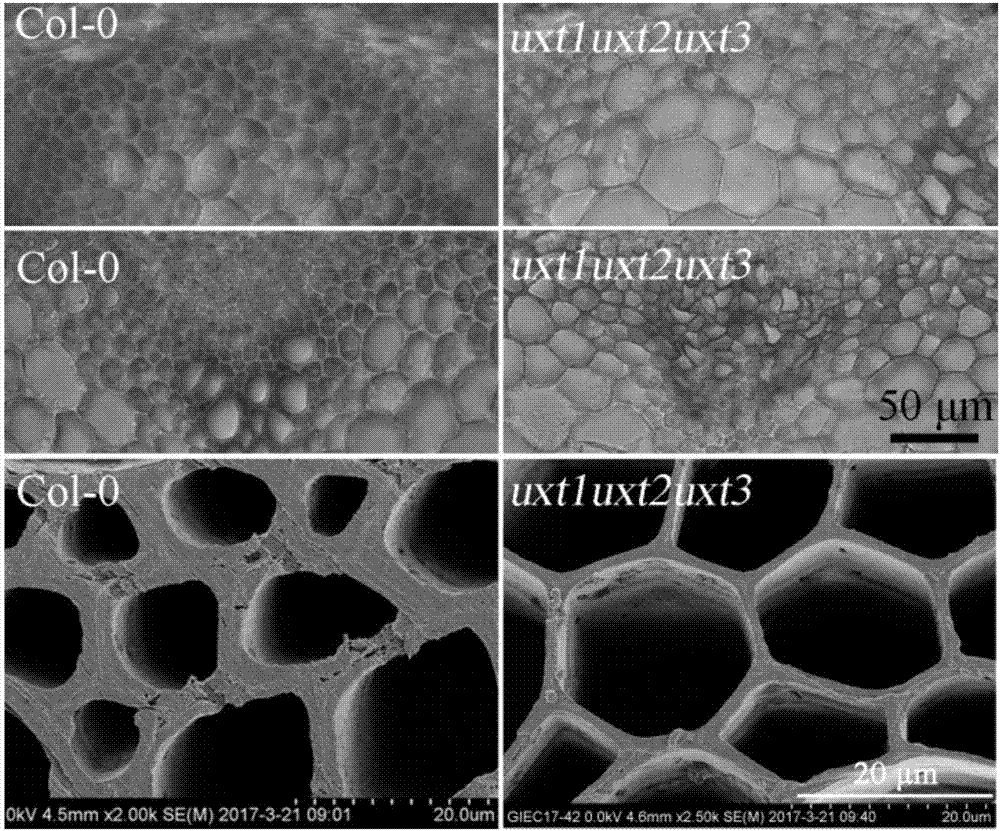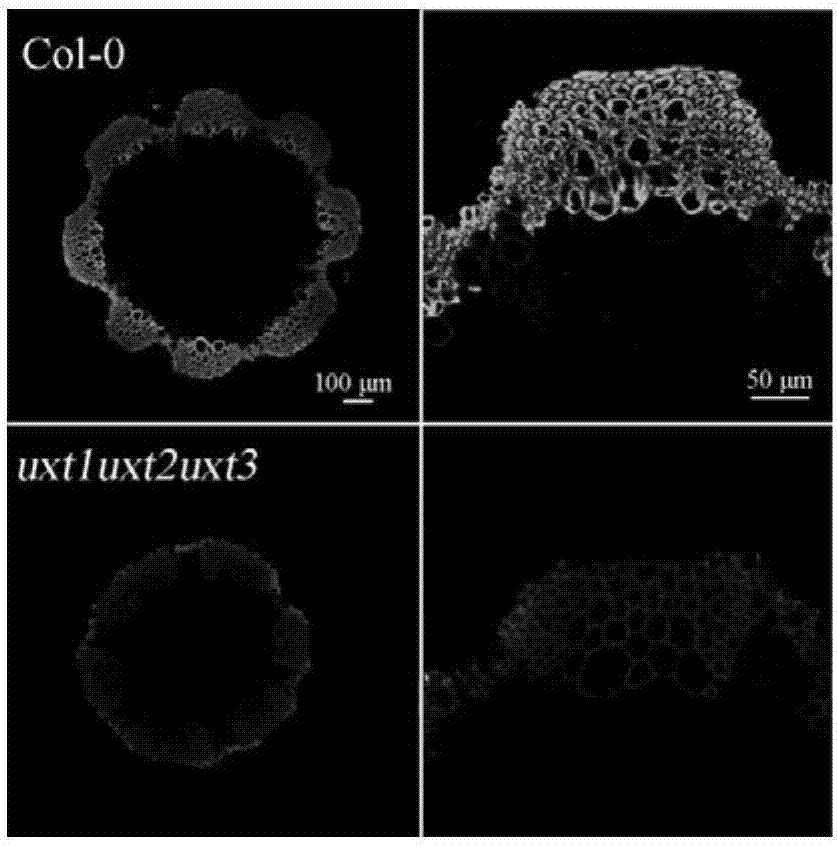Method for increasing saccharification efficiency of plants by down-regulating UXT (UDP-Xylose transporter) gene and application of method
A technology for saccharification efficiency and plant sugar, which is applied in the directions of botanical equipment and methods, biochemical equipment and methods, and applications, can solve problems such as affecting saccharification efficiency, and achieve the goal of reducing labor intensity, increasing relative content, and reducing xylose content. Effect
- Summary
- Abstract
- Description
- Claims
- Application Information
AI Technical Summary
Problems solved by technology
Method used
Image
Examples
Embodiment 1
[0033] Acquisition of T-DNA Line with mutation of AtUXT gene. Three AtUXT mutants were ordered from ABRC (Arabidopsis Biological Resource Center): uxt1 (SALK_086773), uxt2 (SALK_091753) and uxt3 (SALK_079036.37.50.x). The corresponding T-DNA Line identification primers were synthesized on the website of SALK (Salk Institute Genomic Analysis Laboratory, http: / / signal.salk.edu), as shown in Table 1. The three mutants were crossed, and double mutants uxt1uxt3 and uxt2uxt3 were firstly obtained, and these two double mutants were crossed to obtain a triple mutant uxt1uxt2uxt3. The uxt1uxt2uxt3 triple mutant grew short, had dark green leaves, and had a very low amount of seeds in pods ( figure 1 ).
[0034] Table 1 T-DNA Line Identification Primers
[0035] mutant
Embodiment 2
[0037] Preparation and observation of stem sections of Arabidopsis thaliana. Select the main stem of the plant that has grown for 6 to 7 weeks, take a 1 cm stem section 3 cm above the soil surface, embed the stem section with 3% (w / v) agarose, and slice it on a Leica VT1000S vibrating microtome with a thickness of 40 μm. Stain with blue for 1-2 minutes, place on a glass slide, observe and take pictures under an optical microscope. The wood fiber cell wall of wild-type Col-0 was significantly thicker than that of the uxt1uxt2uxt3 triple mutant, and the morphology of xylem vessels of wild-type Col-0 was normal ( figure 2 ), the uxt1uxt2uxt3 triple mutant has irregular vessel morphology and a high collapse ratio ( figure 2 ). Further, the slices were observed under a scanning electron microscope, and the slices were placed on the sample stage to be plated with gold, and then observed under a Hitachi Ion Sputter E-1010 (HITACHI) scanning electron microscope. It was found that...
Embodiment 3
[0039] Chemical immunological observation was performed on the slices used for optical microscope observation in Example 2. Spread 2 layers of filter paper in a Petri dish, soak it with deionized water, place a layer of Parafilm membrane on it, and place the slices on the Parafilm membrane. Then perform chemical immunostaining according to the following steps: use 0.1M phosphate buffer solution (PhosphateBuffer Solution, PBS; 1L: 0.218g KH 2 PO 4 , 1.463g K 2 HPO 4 , 29.22g NaCl, pH 7.2) to wash the slices for 5-10min; soak the slices in fresh 3% (w / v) skim milk for 1h, during which the skim milk was continuously blown; remove the skim milk, and wash the slices with PBS buffer for 5min; primary antibody Incubation: Incubate slices with 20-fold diluted rat anti-xylan antibody LM10 (Plantprobes) for 1 h, wash slices with PBS buffer 10 times to wash unbound primary antibody; secondary antibody incubation: use 50-fold diluted FITC- Goat anti-rat antibody (Zomanbio, Cat. Z1319)...
PUM
 Login to View More
Login to View More Abstract
Description
Claims
Application Information
 Login to View More
Login to View More - R&D
- Intellectual Property
- Life Sciences
- Materials
- Tech Scout
- Unparalleled Data Quality
- Higher Quality Content
- 60% Fewer Hallucinations
Browse by: Latest US Patents, China's latest patents, Technical Efficacy Thesaurus, Application Domain, Technology Topic, Popular Technical Reports.
© 2025 PatSnap. All rights reserved.Legal|Privacy policy|Modern Slavery Act Transparency Statement|Sitemap|About US| Contact US: help@patsnap.com



